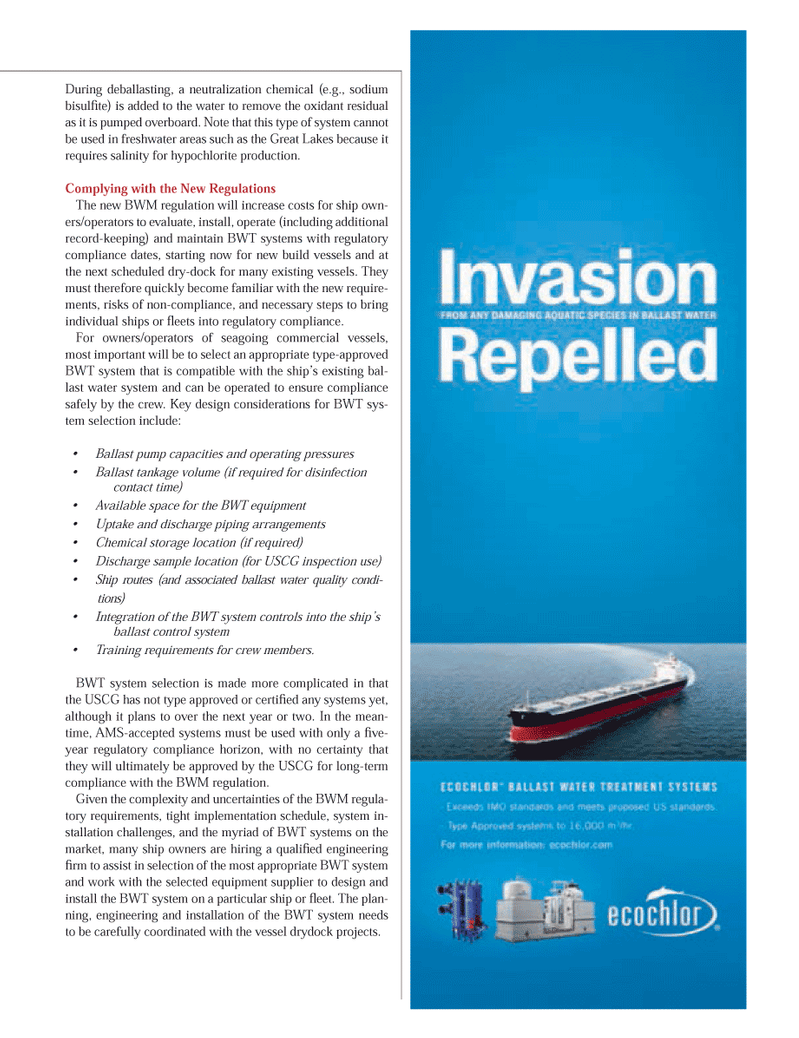
Page 57: of Maritime Logistics Professional Magazine (Q4 2013)
Shipbuilding, Repair
Read this page in Pdf, Flash or Html5 edition of Q4 2013 Maritime Logistics Professional Magazine
During deballasting, a neutralization chemical (e.g., sodium bisulÞ te) is added to the water to remove the oxidant residual as it is pumped overboard. Note that this type of system cannot be used in freshwater areas such as the Great Lakes because it requires salinity for hypochlorite production. Complying with the New RegulationsThe new BWM regulation will increase costs for ship own- ers/operators to ev aluate, install, operate (including additional record-keeping) and maintain BWT systems with regulatory compliance dates, starting now for new build vessels and at the next scheduled dry-dock for many existing vessels. They must therefore quickly become familiar with the new require- ments, risks of non-compliance, and necessary steps to bring individual ships or ß eets into regulatory compliance. For owners/operators of seagoing commercial vessels, most important will be to select an appropriate type-approved BWT system that is compatible with the shipÕs existing bal- last water system and can be operated to ensure compliance safely by the crew. Key design considerations for BWT sys- tem selection include: Ballast pump capacities and operating pressures Ballast tankage volume (if required for disinfection contact time) Available space for the BWT equipment Uptake and discharge piping arrangements Chemical storage location (if required) Discharge sample location (for USCG inspection use) Ship routes (and associated ballast water quality condi- tions) Integration of the BWT system controls into the ship?s ballast control system Training requirements for crew members. BWT system selection is made more complicated in that the USCG has not type approved or certiÞ ed any systems yet, although it plans to over the next year or two. In the mean- time, AMS-accepted systems must be used with only a Þ ve- year regulatory compliance horizon, with no certainty that they will ultimately be approved by the USCG for long-term compliance with the BWM regulation. Given the complexity and uncertainties of the BWM regula- tory requirements, tight implementation schedule, system in-stallation challenges, and the myriad of BWT systems on the market, many ship owners are hiring a qualiÞ ed engineering Þ rm to assist in selection of the most appropriate BWT system and work with the selected equipment supplier to design and install the BWT system on a particular ship or ß eet. The plan- ning, engineering and installation of the BWT system needs to be carefully coordinated with the vessel drydock projects. MP #4 50-63.indd 57MP #4 50-63.indd 5712/11/2013 2:14:48 PM12/11/2013 2:14:48 PM

 56
56

 58
58
